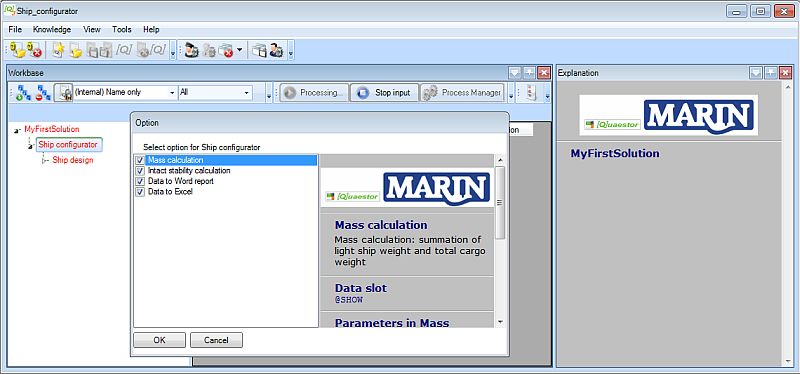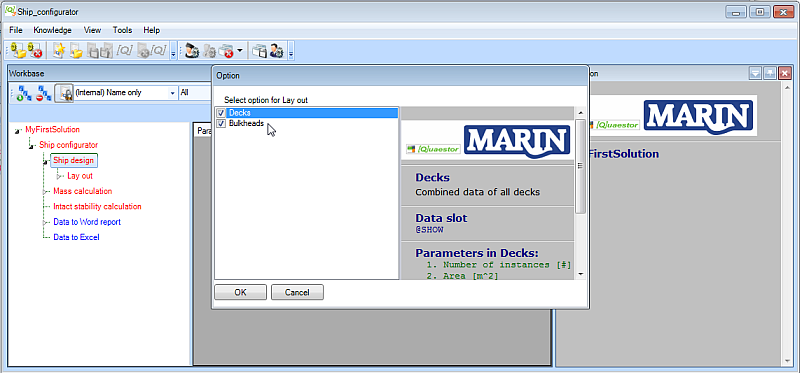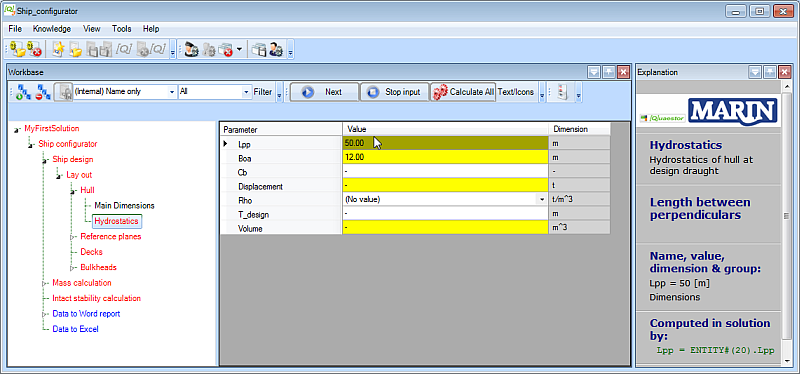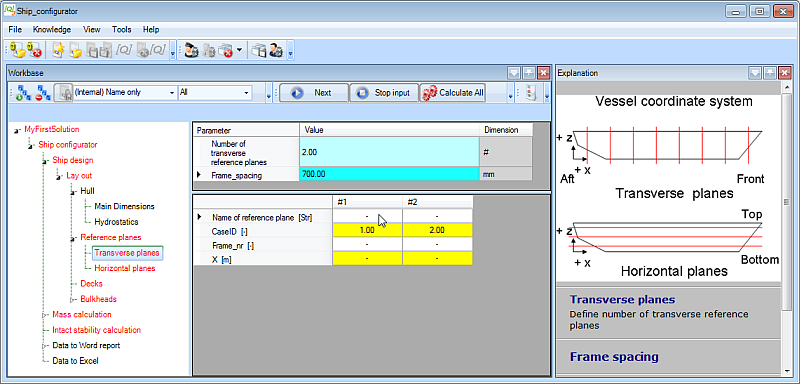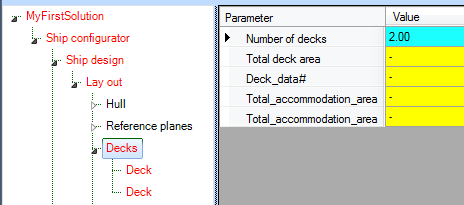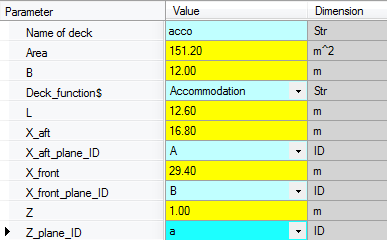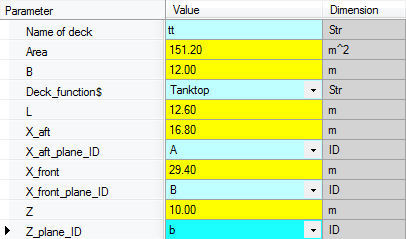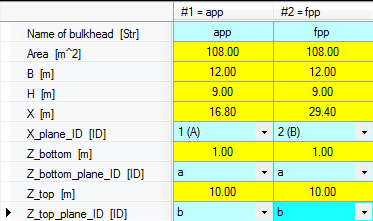1 Start process manager
In what follows, you will configure a very simplified virtual ship design and perform all optional analyses that are included in the knowledge base. This should give you a good impression of the process flow and will discuss the most common aspects of performing a Quaestor analysis based on the taxonomy approach.
A new design configuration starts with opening the Process Manager.
- Click on the Process Manager Button. Click Yes when asked if you want to create a new solution and give it a meaningful name.
After you have provided a solution title and continue, a tree structure is built in the Workbase in which the first node (entity) has the name of your solution. This has a child Ship configurator and this has a child Ship design.
2 Select process steps
An options window appears which shows the available process steps. You can select those that you want to perform:
- For this tutorial, select all of them and click OK.
Please note that you can also decide to carry out only a part of the process steps. When you want to add other steps later, select the entity Ship configurator, press Ctrl+F5 and the options window will reappear.
Quaestor automatically checks dependencies between process steps. For example, select “Intact stability calculation” only. Now Quaestor automatically selects “Mass calculation” because “Intact stability calculation” apparently requires information from “Mass calculation”.
3 Select optional entities
After selecting the process steps, some entities are added to the tree structure. Now, you can select the optional entities Decks and Bulkheads.
- For this tutorial, select both of them and click OK.
When you have selected the options Decks and Bulkheads, both entities are added below entity Lay out.
Entities can have one of three colors:
- red : user input is required within this entity or it's child entities, to determine all information needed for this entity
- blue : no more user input is required within this entity; nevertheless some information is not yet determined. A reason can be that information in other entities has to be determined first.
- black : all information within the entity is determined, thus no user input is required and or no parameters need to be calculated.
4 Navigate processes
As soon as you start a new solution, the process buttons change their status and names. When you click the active button Next, the next input is asked. Stop input does just that. There can be other actions mentioned as well. There is now also a Calculate All button. When you click it, Quaestor will try to calculate all blue entities within your solution.
To perform an analysis, carry out changes, etc. the Quaestor process has to be started by clicking Data input. The process is active when the Next button is shown and stopped when the Data input button is shown again.
In general, working through the process is very straightforward. You can provide input values that are presented in the Workbase either in white or light blue and click Next. You are guided in a “logical sequence” through the whole conceptual design process (for this Ship configurator) as developed by the knowledge engineer (the developer of the knowledge base).
You can always decide to carry out only part of the conceptual design steps or provide the input in a different order. Just go to the pertaining parts in the tree and continue. Any relation between necessary input and steps in the process is taken care of by Quaestor. In other words, when input is required, it will eventually be requested. Furthermore, it is shown by the colors of the entities.
5 Provide input values
Now, entity Main Dimensions is in focus and input values are requested in the list view:
Once an input value is given, the cell color changes to light blue. You can always change your input values later on.
- Enter input values as shown here and click Next:
Now, entity Hydrostatics becomes selected in the tree:
You see that yellow and white cells are shown. A yellow cell means that a value is a Top Goal for the analysis (inside the entity) and it will be determined by a relation. For example, select Lpp in the Entity (shown in Figure 13) and you can see that the value is computed by means of the relation Lpp = Entity#(20).Lpp, as shown in the Explanation window on the right.
If you do not have the explanation part “Computed in solution by:”, please select Tools > Options > Explanation and check Requested by/determined by.
A Knowledge Engineer can define a minimum and/or maximum value for a parameter. Quaestor will issue a warning if the computed or input value exceeds the indicated boundaries.
- Enter value
2for parameterCband press Enter.
A warning message appears, telling you that Cb should be between 0 and 1. After you click OK, you will see that the value does get accepted anyway!
- Enter input values as shown here and click Next:
Please note that the resulting value for parameter Volume is presented as a light blue cell, which is the default color to present an input value. However, this parameter is calculated by Volume = Cb*Lpp*Boa*T_design, as you can see when you select the parameter and look in the Explanation window. The reason is, that parameter Volume is defined as a special proposed value, which can be edited after calculation. When you modify the proposed value, the cell will turn red in order to indicate that a proposed value is modified. To return to the proposed value again, select the value and press the space bar to delete the value and press enter. Now the proposed value is calculated and shown again in light blue.
6 Define the reference planes
For the ship configurator, it is decided to define reference planes first. These can then be used to locate other objects like Decks and Bulkheads in a ship design, and then define the arrangement itself. Whenever you change a value of a single reference plane, Quaestor propagates the changed value through the whole solution. Therefore, using reference planes is a powerful method to develop a parametric design.
Now, entity Transverse planes will be selected in the tree. The definitions of reference planes and the coordinate system of the vessel are shown in the Explanation window with a schematic picture. The picture size can be changed by resizing the Explanation window. The default proposed value of parameter “Frame_spacing” is 700 [mm], which can be modified. You have to provide the number of transverse reference planes you want to add to your solution
- Enter 2 as the number of transverse reference planes and press Enter. Select New empty Case(s) from the window that pops up after this.
Now a table of 2 columns is created in the table view, each representing a transverse reference plane. You have to enter a frame number and a name for every plane (any recognizable name will do). Quaestor will calculate the X position of a transverse reference plane by X = Frame_nr * Frame_spacing.
- Enter input values as shown here and click Next:
The horizontal reference planes will be defined by the same procedure.
- Select entity
Horizontal planesin the tree. - Enter 2 as the number of horizontal reference planes and press Enter. Select New empty Case(s) from the window that pops up after this.
- Enter input values as shown here and click Next:
7 Define decks and bulkheads
You have selected optional entity Decks, so you have to indicate the number of Deck entities you want to include. These will be automatically placed below entity Decks. In this tutorial we need two decks.
- Select entity
Decksin the tree. - Enter 2 as value of the
Number of decksand press Enter.
Next you have to define a name and a deck function for every deck. A deck function can be selected from a drop down box. To locate a deck within your ship design, you have to relate the aft and front position of a deck to one of your defined transverse reverences planes and the height of a deck to one of your defined horizontal reference planes. You can refer to your defined reference planes by selecting one of your defined reference names that will be shown in a drop down menu.
As you can see above, the total accommodation area will be computed at the level of entity Decks. Total_accommodation_area results from the summation of all areas of Deck's, using the Deck_function$ named 'Accommodation'.
- Select the first entity
Deckin the tree. - Enter input values as shown here and click Next:
For the second deck the same parameters are requested. Here, another Deck_function$ is used. Please note that in the mean time, the entity node name in the tree view of the first deck is changed into a more recognizable name than just Deck. Now the entity node name of the first Deck contains the name of the deck and the deck height.
- Select the second entity
Deckin the tree. - Enter input values as shown here and click Next:
- Select entity
Bulkheadsin the tree.
This ship configurator uses an entity structure for defining (transverse) bulkheads that differs from the one used for the decks. Of course, the same entity structure could be used, but it is more instructive to present a different presentation form. First, you have to provide the number of bulkheads you want to include in your ship design.
- Enter 2 as the value for
Number of bulkheadsand press Enter. Select New empty Case(s) from the window that pops up after this.
Now a table of two columns is created in the table view, each representing a single bulkhead. After completing entity Bulkheads the ship lay out is completed.
- Enter input values as shown here and click Next:
